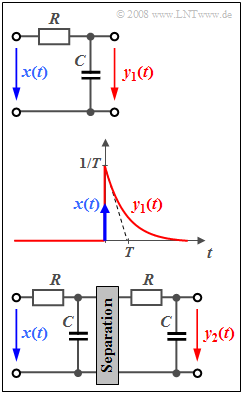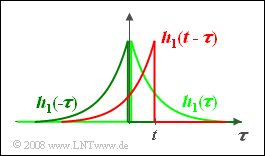Exercise 1.4: Low-Pass Filter of 2nd Order
In Exercise 1.1 and Exercise 1.1Z of the chapter System Description in Frequency Domain the so-called "RC low-pass filters" were described in the frequency domain. Now, the time domain representation is elaborated on.
The circuit with the input signal $x(t)$ and the output signal $y_1(t)$ is a low-pass filter of first order with frequency response
- $$H_{\rm 1}(f) = \frac{1}{1+{\rm j}\cdot f/f_{\rm 0}}.$$
Here, $f_0 = 1/(2πRC)$ indicates the 3dB cut-off frequency. If a Dirac-shaped signal $x(t) = δ(t)$ is applied to the input, the signal $y_1(t)$ is given by the system output according to the sketch in the middle.
The relationship between the system parameters $R$ (resistance), $C$ (capacitance) and $T$ is (see Exercise 1.3Z):
- $$T = \frac{1}{\omega_{\rm 0}}= \frac{1}{2\pi f_{\rm 0}} = R \cdot C.$$
For numerical calculations $T = 1 \ \rm ms$ shall be used in the following.
The circuit below with input $x(t)$ and output $y_2(t)$ represents a low-pass filter of second order:
- $$H_{\rm 2}(f) = \big[H_{\rm 1}(f)\big]^2 =\frac{1}{(1+{\rm j}\cdot f/f_{\rm 0})^2}.$$
- The impulse response associated with $H_2(f)$ is $h_2(t)$.
- The system parameter $f_0$ no longer indicates the 3dB cut-off frequency for a low-pass filter of second or higher order.
- Furthermore, it should be noted that the two RC elements must be decoupled in order to achieve impedance matching.
- An operational amplifier, for example, is suitable for this. However, this hint is not relevant for the solution of this task.
Please note:
- The exercise belongs to the chapter System Description in Time Domain.
- The following indefinite integral is given:
- $$\int u \cdot {\rm e}^{a \cdot \hspace{0.03cm} u} \hspace{0.1cm}{\rm d}u = \frac{{\rm e}^{\hspace{0.03cm}a \cdot \hspace{0.03cm} u}}{a^2} \cdot (a \cdot u -1).$$
Questions
Solution
- According to the solution of Exercise 1.3Z and the sketch above the following holds:
- $$h_1(t) = y_1(t) ={1}/{T} \cdot {\rm e}^{-t/T}.$$
- For the time $t_1$ the following shall hold:
- $$h_1(t_{\rm 1}) ={1}/{T} \cdot {\rm e}^{-t_{\rm 1}/T} = \frac{1}{2T} \hspace{0.5cm}\Rightarrow\hspace{0.5cm}{t_{\rm 1}}/{T} = {\rm ln}(2)\hspace{0.1cm} \Rightarrow \hspace{0.1cm}t_{\rm 1} = 0.693 \cdot T \hspace{0.15cm}\underline{= {\rm 0.693\,\,ms}}.$$
(2) The input signal $x(t)$ is an exponentially decreasing impulse like the impulse response $h_1(t)$ but dimensionless.
- Thus, according to the convolution theorem:
- $$y_1(t) = x (t) * h_1 (t) = T \cdot \big[ h_1 (t) * h_1 (t) \big].$$
- The convolution is illustrated here for a specific time $t$ by a sketch.
- The following is obtained after renaming the variables:
- $$\begin{align*}h_1(\tau) & = \frac{1}{T} \cdot {\rm e}^{-\tau/T}\hspace{0.1cm} \Rightarrow \hspace{0.1cm}h_1(-\tau) = \frac{1}{T} \cdot {\rm e}^{\tau/T}\hspace{0.1cm} \Rightarrow \hspace{0.1cm}h_1(t-\tau) = \frac{1}{T} \cdot {\rm e}^{(-t+\tau)/T} \\ & \Rightarrow\hspace{0.5cm} y_1(t) = T \cdot \int\limits_{ - \infty }^{ + \infty } h_1 ( {t - \tau } )\cdot {h_1 ( \tau )} \hspace{0.1cm}{\rm d}\tau.\end{align*}$$
- For $τ < 0$ the impulse response is $h_1(τ) = 0$. For $τ > t$ the first convolution operand vanishes (see sketch). From this it follows that:
- $$y_1(t) = T \cdot \frac{1}{T^2}\cdot \int_{ 0 }^{ t } {\rm e}^{(-t+\tau)/T} \cdot {\rm e}^{-\tau/T} \hspace{0.1cm}{\rm d}\tau = \frac{1}{T}\cdot \int_{ 0 }^{ t } {\rm e}^{-t/T} \hspace{0.1cm}{\rm d}\tau .$$
- Now, it can be observed that the integrand is independent of the integration variable $τ$. Consequently, the following holds:
- $$y_1(t) = {t}/{T} \cdot {\rm e}^{-t/T}\hspace{0.1cm} \Rightarrow \hspace{0.1cm} y_1(t =0) \hspace{0.15cm}\underline{=0}; \hspace{0.5cm}y_1(t =T)={\rm e}^{-1} \hspace{0.15cm}\underline{=0.368}.$$
(3) Due to the interrelationship $H_2(f) = H_1(f) · H_1(f)$ the following holds for the impulse response: $h_2(t) = h_1 (t) * h_1 (t).$
- Except for the additional constant factor $1/T$ the same result as in subtask (2) is obtained:
- $$h_2(t) ={t}/{T^2} \cdot {\rm e}^{-t/T}.$$
- The maximum value is obtained by setting the derivative to zero:
- $$\frac{{\rm d} h_2(t)}{{\rm d}t} = \frac{1}{T^2} \cdot {\rm e}^{-t/T} \cdot \left( 1 - {t}/{T}\right) = 0 \hspace{0.5cm} \Rightarrow \hspace{0.5cm} t_{\rm 2} \hspace{0.15cm}\underline{= T = 1\,\,{\rm ms}} \hspace{0.5cm}\Rightarrow \hspace{0.5cm} h_2(t_{\rm 2}) =\frac{{\rm e}^{-1}}{T} =\frac{0.368}{1\,\,{\rm ms}} \hspace{0.15cm}\underline{ = {\rm 368 \hspace{0.1cm} 1/s}}.$$
(4) In general or with the result from (3) the following applies to the step response:
- $${\rm \sigma_2}(t) = \int_{ 0 }^{ t } {h_2 ( \tau )} \hspace{0.1cm}{\rm d}\tau = \frac{1}{T^2} \cdot \int_{ 0 }^{ t } \tau \cdot {\rm e}^{-\tau/T} \hspace{0.1cm}{\rm d}\tau .$$
- With the substitution $u = τ/T$ and using the given integral it follows that:
- $${\rm \sigma_2}(t) = \int_{ 0 }^{ t /T} u \cdot {\rm e}^{-u} \hspace{0.1cm}{\rm d}u ={\rm e}^{-u} \cdot (-u-1) |_{ 0 }^{ t /T} \hspace{0.5cm} \Rightarrow \hspace{0.5cm}{\rm \sigma_2}(t) = 1- \left( 1 + {t}/{T} \right) \cdot {\rm e}^{-t/T}.$$
- The following is obtained at the given times taking the factor $2\ \rm V$ further into account:
- $$y_2(t = T) = {\rm 2 \,V} \cdot \left( 1- 2 \cdot {\rm e}^{-1} \right) \hspace{0.15cm}\underline{= {\rm 0.528 \,V}}, \hspace{0.9cm}y_2(t = 5T) = {\rm 2 \,V} \cdot \left( 1- 6 \cdot {\rm e}^{-5} \right) \hspace{0.15cm}\underline{= {\rm 1.919 \,V}}.$$
- For even larger times $y_2(t)$ approaches more and more the final value $2\hspace{0.05cm} \rm V$ .

